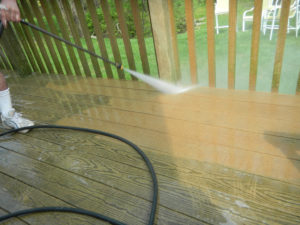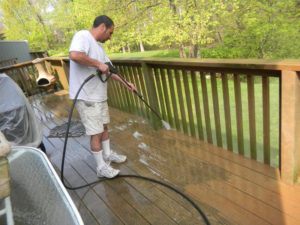 Both composite and wooden decks need regular maintenance that can extend their life, appeal, and save you from having to make expensive repairs. Composite woods are made of a material that is a combination of plastic and wood fibers held together with a binding agent. This kind of lumber is tougher, denser, and weighs more than conventional wood. You can use pressure washing to clean any kind of material used to build the deck. Not only will you use less water as compared to the typical garden hose, but also you can save on time and achieve a more effective cleaning.
Both composite and wooden decks need regular maintenance that can extend their life, appeal, and save you from having to make expensive repairs. Composite woods are made of a material that is a combination of plastic and wood fibers held together with a binding agent. This kind of lumber is tougher, denser, and weighs more than conventional wood. You can use pressure washing to clean any kind of material used to build the deck. Not only will you use less water as compared to the typical garden hose, but also you can save on time and achieve a more effective cleaning.
Equipment Needed
Wooden decks must be cleaned using the right kind of equipment that will not damage the surface of the wood by gouging out depressions. Here’s what you need:
- Pressure Washer: Both gas-powered and electric-powered washers pressure work well. If you’re working on a pine or cedar deck, pick a machine that gives you a PSI of 500 to 600. Composite decks can be cleaned using a PSI of 800.
- Nozzles: You’ll need spray tips with 25° to 40° with the nozzles or opt for an adjustable nozzle so you can adjust the tips according to the dirt you’re cleaning up. Wooden decks must be cleaned using a fan spray or rotating tip only. Also, get a black nozzle that can spray detergent.
- Detergent and Chemicals: Choose the appropriate detergent according to the kind of wood you’re cleaning, like for example, cedar or composite. You’ll also need to buy eco-friendly chemicals in case you’re dealing with tough stains of mold and mildew. Make sure you get the right sealants also.
- Brushes: You’ll need stiff brushes with synthetic bristles and long handles to clean off any mold and mildew. Never use metal bristles or you could damage the fibers of the wood. Check with your supplier and buy the roller brushes you need for applying the sealant on the wood. Have a soft broom along for sweeping up loose debris.
- Safety Gear: Bring safety gear such as goggles for your eyes, gloves, boots, and long pants.
- Sanding Gear: Bring 60 to 80-grit sandpaper along with a random orbital sander with a 5-inch pad for dealing with raised fibers.
Prepping the Worksite
Clear the deck of furniture, toys, planters, or any other items so that they don’t encumber the pressure cleaning. Using a soft broom, sweep away leaves, branches, dust, and other loose debris. Having cleared the area, you’ll have a clearer view of the mold and mildew that might form under furniture and other fixtures. If the stains are mild, power washing can get rid of them, but if they are tough, you’ll need to use removing agents. Following the manufacturer’s instructions spread the solution on the stains and scrub them away with the stiff brush.
Pressure Cleaning Procedure
When you begin with the pressure cleaning, keep a few important factors in mind. Never use hot water on wood or you’ll raise too much of the wood fibers. You must always take care never to use excessive pressure on the wood or you risk wearing it away. The power washing you undertake is intended to remove a very fine layer of the graying surface so that the actual color of the wood can show from beneath the dirt and discoloration. Here’s what you need to do:
- Wet the deck and the surrounding plants and soil with a regular garden hose so that the cleaning solutions and detergents you’re using do not damage them. However, if the dirt and grime is mild, you need not use detergent and clean the deck using the power washer only.
- Using the black nozzle, spray the soap with even strokes beginning at the house end and moving to the outer edge. Let your strokes overlap a little for effective cleaning. Remove dirt from the hard to reach spots with the help of the brush.
- Take care not to let the detergent dry on the wood or it could cause streaking and damage. If it seems too dry, wet it by misting gently.
- Before you begin rinsing, test the pressure on a hidden corner of the deck. The pressure should be just enough to remove the dirt and grime and allow the original color of the deck to show through. Anything more than that and you risk etching or splintering the wood.
- Attach the 25° to 40° fan spray tip and begin rinsing the deck. Hold the tip two feet from the surface keeping a close watch on the changing color. If you need to, you can move it closer to 6 to 12 inches, but never less than 6 inches. If you feel you’re not getting effective results, it is preferable to go over the area a second time.
- Take care to use steady strokes working from the house side to the edge along the grain of the wood. Alternatively, if the deck has no railings, you could use a lengthwise motion from one end of the deck to the other moving horizontally to the house. Remember to allow for overlapping so that there are no unsightly cleaning marks.
- Be careful when spraying corners or you risk the water, detergent, and debris splashing back on you. It is advisable to use an L-shaped motion to clean corners.
Dealing With raised Wood Fibers
 You must give the deck at least 24 hours to dry completely or more depending on weather conditions. Once the deck has dried, you’ll likely notice raised fibers and splinters that occur when the wood is wet or as a result of the pressure cleaning. You might also notice residual stains that are not apparent until the wood has dried. You can take care of these issues by sanding down the stains and roughened wood using 60 to 80-grit sandpaper. Take care not to use finer sandpaper or you risk smoothening the wood to a point when it will not soak in the sealant or staining agent you use later.
You must give the deck at least 24 hours to dry completely or more depending on weather conditions. Once the deck has dried, you’ll likely notice raised fibers and splinters that occur when the wood is wet or as a result of the pressure cleaning. You might also notice residual stains that are not apparent until the wood has dried. You can take care of these issues by sanding down the stains and roughened wood using 60 to 80-grit sandpaper. Take care not to use finer sandpaper or you risk smoothening the wood to a point when it will not soak in the sealant or staining agent you use later.
Finishing the Deck
If the deck is exposed to harsh sunlight very often, you can use an ultraviolet blocking stain with the appropriate pigmentation to protect it from future damage. The pigmentation can help restore the wood’s original color and allow the grains to show through. For issues with moisture and frequent rain, you can use an oil-based wood preserving agent as a waterproofing sealer. Give the deck 48 hours to dry completely before applying the sealant using a roller brush. You can also spray it on with a compressed-air sprayer or garden sprayer depending on the kind of solution you’ve chosen. While one coat is adequate to cover the wood, apply a second coat if the wood is too dry.
Power washing or pressure washing, when used with caution is an ideal method for cleaning decks of accumulated dirt, debris, and other residue. To maintain the effects of the pressure cleaning, you can hose the decks down with clean water from time to time. This strategy can help keep them spotless and free of mildew.
References:
1. Formisano, Bob. “How to Power Wash a Wood Deck.”About Home. 20 July, 2016. Web. 7 Sep. 2016.
2.“Using a Pressure Washer to Clean a Deck.”Decks. com. n.d. Web. 7 Sep. 2016.
3. DiClerico, Daniel. “How to Clean a Deck With a Pressure Washer.”ConsumerReports. 27 May 2016. Web. 7 Sep. 2016.
4.“How to Power Wash & Seal a Deck.” n.d. Web. 7 Sep. 2016.
5.“How to Pressure Wash a Composite Deck.”. Doityourself. n.d. Web. 7 Sep. 2016.






